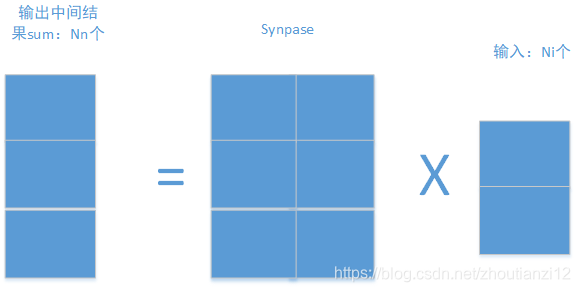2016:DianNao Family Energy-Efficient Hardware Accelerators for Machine Learning-程序员宅基地
技术标签: pr
文章目录
- 这个发表在了
- https://cacm.acm.org/
- communication of the ACM
- 上
- 参考文献链接是
Chen Y , Chen T , Xu Z , et al.
DianNao Family: Energy-Efficient Hardware Accelerators for Machine Learning[J].
Communications of the Acm, 2016, 59(11):105-112


- https://cacm.acm.org/magazines/2016/11/209123-diannao-family/fulltext
- 果然找到了他

- 特码的,我下载了,6不6
The original version of this paper is entitled “DianNao: A
Small-Footprint, High-Throughput Accelerator for Ubiq-
uitous Machine Learning” and was published in Proceed-
ings of the International Conference on Architectural Support
for Programming Languages and Operating Systems (ASPLOS)
49, 4 (March 2014), ACM, New York, NY, 269–284.
Abstract
- ML pervasive
- broad range of applications
- broad range of systems(embedded to data centers)
- broad range of applications
- computer
- toward heterogeneous multi-cores
- a mix of cores and hardware accelerators,
- designing hardware accelerators for ML
- achieve high efficiency and broad application scope
第二段
- efficient computational primitives
- important for a hardware accelerator,
- inefficient memory transfers can
- potentially void the throughput, energy, or cost advantages of accelerators,
- an Amdahl’s law effect
- become a first-order concern,
- like in processors,
- rather than an element factored in accelerator design on a second step
- a series of hardware accelerators
- designed for ML(nn),
- the impact of memory on accelerator design, performance, and energy.
- representative neural network layers
- 450.65x over GPU
- energy by 150.31x on average
- for 64-chip DaDianNao (a member of the DianNao family)
1 INTRODUCTION
- designing hardware accelerators which realize the best possible tradeoff between flexibility and efficiency is becoming a prominent
issue.
- The first question is for which category of applications one should primarily design accelerators?
- Together with the architecture trend towards accelerators, a second simultaneous and significant trend in high-performance and embedded applications is developing: many of the emerging high-performance and embedded applications, from image/video/audio recognition to automatic translation, business analytics, and robotics rely on machine learning
techniques. - This trend in application comes together with a third trend in machine learning (ML) where a small number
of techniques, based on neural networks (especially deep learning techniques 16, 26 ), have been proved in the past few
years to be state-of-the-art across a broad range of applications. - As a result, there is a unique opportunity to design accelerators having significant application scope as well as
high performance and efficiency. 4
第二段
- Currently, ML workloads
- mostly executed on
- multicores using SIMD[44]
- on GPUs[7]
- or on FPGAs[2]
- the aforementioned trends
- have already been identified
- by researchers who have proposed accelerators implementing,
- CNNs[2]
- Multi-Layer Perceptrons [43] ;
- accelerators focusing on other domains,
- image processing,
- propose efficient implementations of some of the computational primitives used
- by machine-learning techniques, such as convolutions[37]
- There are also ASIC implementations of ML
- such as Support Vector Machine and CNNs.
- these works focused on
- efficiently implementing the computational primitives
- ignore memory transfers for the sake of simplicity[37,43]
- plug their computational accelerator to memory via a more or less sophisticated DMA. [2,12,19]
- efficiently implementing the computational primitives
第三段
-
While efficient implementation of computational primitives is a first and important step with promising results,
inefficient memory transfers can potentially void the throughput, energy, or cost advantages of accelerators, that is, an
Amdahl’s law effect, and thus, they should become a first-
order concern, just like in processors, rather than an element
factored in accelerator design on a second step. -
Unlike in processors though, one can factor in the specific nature of
memory transfers in target algorithms, just like it is done for accelerating computations. -
This is especially important in the domain of ML where there is a clear trend towards scaling up the size of learning models in order to achieve better accuracy and more functionality. 16, 24
第四段
- In this article, we introduce a series of hardware accelerators designed for ML (especially neural networks), including
DianNao, DaDianNao, ShiDianNao, and PuDianNao as listed in Table 1. - We focus our study on memory usage, and we investigate the accelerator architecture to minimize memory
transfers and to perform them as efficiently as possible.
2 DIANNAO: A NN ACCELERATOR
- DianNao
- first of DianNao accelerator family,
- accommodates sota nn techniques (dl ),
- inherits the broad application scope of nn.
2.1 Architecture
- DianNao
- input buffer for input (NBin)
- output buffer for output (NBout)
- buffer for synaptic(突触) weights (SB)
- connected to a computational block (performing both synapses and neurons computations)
- NFU, and CP, see Figure 1

NBin是存放输入神经元
SB是存放突触的权重的
这个NBout是存放输出神经元
我觉得图示的可以这样理解:2个输入神经元,2个突触,将这2个对应乘起来,输出是1个神经元啊。但是我的这个NFU牛逼啊,他可以一次性求两个输出神经元。
NFU
- a functional block of T i T_i Ti inputs/synapses(突触)
- T n T_n Tn output neurons,
- time-shared by different algorithmic blocks of neurons.
这个NFU对 T i T_i Ti个输入和突触运算,得到 T n T_n Tn个输出神经元,突触不是应该是 T i × T n T_i\times T_n Ti×Tn个吗??,
- Depending on the layer type,
- computations at the NFU can be decomposed in either two or three stages
- For classifier and convolutional:
- multiplication of synapses × \times × inputs:NFU-1
- , additions of all multiplications, :NFU-2
- sigmoid. :NFU-3
如果是分类层或者卷积的话的话,那就是简单的突触 × \times × 输入,然后加起来,求sigmoid。这个我能理解哦,这种情况不就是卷积吗。
如果是分类层,那么输入就是
- last stage (sigmoid or another nonlinear function) can vary.
- For pooling, no multiplication(no synapse),
- pooling can be average or max.
- adders(加法器) have multiple inputs,
- they are in fact adder trees,
- the second stage also contains
- shifters and max operators for pooling.
要啥移位啊??
- the sigmoid function (for classifier and convolutional layers)can be efficiently implemented using ( f ( x ) = a i x × + b i , x ∈ [ x i , x i + 1 ] f(x) = a_i x \times + b_i , x \in [x_i , x_{i+1} ] f(x)=aix×+bi,x∈[xi,xi+1]) (16 segments are sufficient)
On-chip Storage
- on-chip storage structures of DianNao
- can be construed as modified buffers of scratchpads.
- While a cache is an excellent storage structure for a general-purpose processor, it is a sub-optimal way to exploit reuse because of the cache access overhead (tag check, associativity, line size, speculative read, etc.) and cache conflicts.
- The efficient alternative, scratchpad, is used in VLIW processors but it is known to be very difficult to compile for.
- However a scratchpad in a dedicated accelerator realizes the best of both worlds: efficient
storage, and both efficient and easy exploitation of locality because only a few algorithms have to be manually adapted.
第二段
- on-chip storage into three (NBin, NBout,and SB), because there are three type of data (input neurons,output neurons and synapses) with different characteristics (read width and reuse distance).
- The first benefit of splitting structures is to tailor the SRAMs to the appropriate
read/write width, - and the second benefit of splitting storage structures is to avoid conflicts, as would occur in a cache.
- Moreover, we implement three DMAs to exploit spatial locality of data, one for each buffer (two load DMAs for inputs, one store DMA for outputs).
2.2 Loop tiling
- DianNao 用 loop tiling去减少memory access
- so可容纳大的神经网络
- 举例
- 一个classifier 层
- 有 N n N_n Nn输出神经元
- 全连接到 N i N_i Ni的输入
- 如下图
- 一个classifier 层


N n N_n Nn个输出, N i N_i Ni个输入,sypase应该是 N n × N i N_n\times N_i Nn×Ni大小,用这个矩阵 × N i \times N_i ×Ni即可得到结果啊
- 先取出来一块
- 有点疑惑啊
- 万一右边第一个元素和左边全部元素都有关
- 你咋算啊 ()
- 其实啊,我他妈算右边第一个时候
- 只需要用到和synapse的一行呀!
- 那你那个大大的synapse矩阵咋办啊

- 下面是原始代码和和
- tiled代码
- 他把分类层映射到DianNao

for(int n=0;n<Nn;n++)
sum[n]=0;
for(int n=0;n<Nn;n++) //输出神经元
for(int i=0;i<Ni;i++) //输入神经元
sum[n]+=synapse[n][i]*neuron[i];
for(int n=0;n<Nn;n++)
neuron[n]=Sigmoid(sum[n]);
- 俺的想法:
- 一次来Tnn个输出
- 和Tii个输入
- 然后这个东西对于硬件还是太大了
- 再拆
- 来Tn个和Ti个吧
- 就酱
for(int nnn=0;nnn<Nn;nnn+=Tnn){
//tiling for output 神经元
//第一个for循环准备扔出去Tnn个输出
for(int iii=0;iii<Ni;iii+=Tii){
//tiling for input 神经元
//第二个for循环准备扔进来Tii个输入
//下面就这两个东西动手
for(int nn=nnn;nn<nnn+Tnn;nn+=Tn){
//第三个for循环觉得觉得Tnn还是太大了,继续拆
//大小是Tn
//那么我们对每一个Tnn块!(开始位置是nn哦!!)
//我们如下求解
///
for(int n=nn;n<nn+Tn;n++)
//第一步把中间结果全部搞成零!
sum[n]=0;
//为求sum[n],sum[n]=synapse的第n行乘neuron的全部啊!
for(int ii=iii;ii<iii+Tii;ii+=Ti)
//上面的for是对Ti进行拆
for(int n=nn;n<nn+Tn;n++)
for(int i=ii;i<ii+Ti;i++)
sum[n]+=synapse[n][i]*neuron[i];
for(int nn=nnn;nn<nnn+Tnn;nn+=Tn)
neuron[n]=sigmoid(sum[n]);
///
} } }
- 在tiled代码中, i i ii ii和 n n nn nn
- 表示NFU有 T i T_i Ti个输入和突触
- 和 T n T_n Tn个输出神经元
- 表示NFU有 T i T_i Ti个输入和突触
- 输入神经元被每个输出神经元需要重用
- 但这个输入向量也太他妈大了
- 塞不到Nbin块里啊
- 所以也要对循环 i i ii ii分块,因子 T i i T_{ii} Tii
上面的代码肯定有问题,正确的如下:
for (int nnn = 0; nnn < Nn; nnn += Tnn) {
for (int nn = nnn; nn < nnn + Tnn; nn += Tn) {
for (int n = nn; n < nn + Tn; n++)
sum[n] = 0;
for (int iii = 0; iii < Ni; iii += Tii) {
for (int ii = iii; ii < iii + Tii; ii += Ti)
for (int n = nn; n < nn + Tn; n++)
for (int i = ii; i < ii + Ti; i++)
sum[n] += synapse[n][i] * neuron[i];
}
for (int n = nn; n < nn + Tn; n++)
printf("s%ds ", sum[n]);
}
}
for (int index = 0; index < Nn; index++)
printf("%d ", sum[index]);
智能推荐
html Canvas粒子文字特效_html canvas 效果-程序员宅基地
文章浏览阅读757次,点赞19次,收藏9次。文字动态特效_html canvas 效果
el-table-column 表格列自适应宽度的组件封装说明
针对组件业务上的需求,需要给 el-table-column 加上限制,需保证表头在一行展示,部分列的内容要一行展示,自适应单项列的宽度;
Ali-Sentinel-链路控制
Ali-Sentinel-链路控制
【webrtc】MessageHandler 2: 基于线程的消息处理:以PeerConnectionClient为例
message handler
C语言实现SM4(基于GMSSL)_使用c语言调用openssl实现sm4代码-程序员宅基地
文章浏览阅读4.2k次。环境:vs2019 gmssl 32位编译1、首先新建项目2、在VS的工程设置工程属性(参考连接https://blog.csdn.net/zhonghua_csdn/article/details/99011892)右击工程名 ——> 选择“属性” 在“VC++目录”——> “包含目录”中添加openSSL的include文件(在您安装openssl的文件下) 在“VC++目录”——> “库目录”中添加openSSL的lib文件(在您安装openssl的文件下) 在“._使用c语言调用openssl实现sm4代码
让Windows免疫Autorun病毒-程序员宅基地
文章浏览阅读73次。来源:http://www.bysjhf.com.cn目前,U盘病毒的情况非常严重,几乎所有带病毒的U盘,根目录里都有一个autorun.inf。右键菜单多了“自动播放”、“Open”、“Browser”等项目。由于我们习惯用双击来打开磁盘,但现在我们双击,通常不是打开U盘,而是让autorun.inf里所设的程序自动播放。所以对于很多人来说相当麻烦。其实Autorun...._linux怎么为windows做autorun免疫
随便推点
Qt报错:Error while building/deploying project *** (kit: Desktop Qt 5.12.9 MSVC2017...)_error while building/deploying project xianzhazhi -程序员宅基地
文章浏览阅读1.5k次。Qt Creator 报错:Error while building/deploying project helloworld (kit: Desktop Qt 5.6.2 MinGW 32bit) When executing step "qmake" - zhangjunwu - 博客园 (cnblogs.com)https://www.cnblogs.com/zhangjunwu/p/7417566.html注意:Qt文件路径不要出现中文名字和空格!!!......_error while building/deploying project xianzhazhi (kit: desktop qt 5.12.9 ms
解决create-react-app创建项目出错_installing packages. this might take a couple of m-程序员宅基地
文章浏览阅读1.3k次。Installing packages. This might take a couple of minutes.Installing react, react-dom, and react-scripts with cra-template-typescript...npm ERR! code 1npm ERR! path C:\Users\MHX\Desktop\react-demo\node_modules\canvasnpm ERR! command failednpm ERR! comm_installing packages. this might take a couple of minutes. installing react,
关于西电计科本科学习的一些经验分享与资料汇总_西电毕设拿良容易吗-程序员宅基地
文章浏览阅读1.9w次,点赞43次,收藏214次。关于西电计科本科学习的一些经验分享与资料汇总_西电毕设拿良容易吗
【nodejs】使用express-generator快速搭建项目框架-程序员宅基地
文章浏览阅读279次,点赞9次,收藏3次。项目根目录打开终端,执行以下命令,安装依赖。执行以下命令后,在浏览器中打开。就可以打开这个项目了。
c++二维vector_c++ 二维vector-程序员宅基地
文章浏览阅读8.5k次,点赞4次,收藏24次。关于C++中二维vector使用vector本来就是可以用来代替一维数组的,vector提供了operator[]函数,可以像数组一样的操作,而且还有边界检查,动态改变大小。这里只介绍用它来代替二维的数组,二维以上的可以依此类推。1、定义二维vectorvector<vector<int>> A;//错误的定义方式vector<vector<int> > A;//正缺的定义方式vector<vector<int> > v;/_c++ 二维vector
python算法题_python算法题-程序员宅基地
文章浏览阅读187次。广告关闭腾讯云11.11云上盛惠 ,精选热门产品助力上云,云服务器首年88元起,买的越多返的越多,最高返5000元!导言:记录下学习的算法题,写练多,脑子才能转的快! 今日算法题:二分法查找说下我对于二分法查找的理解:【和猜数字游戏差不多】 要在一个有序数列中找到一个与对应给定数字。 1、找到有序数列中最中间的数字2、若中间值大于给定值,则在左边数列重新二分查找3、若中间值小于给定值,则在右边数列..._python服务端算法题